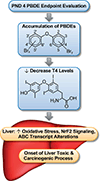Hepatic Transcriptomic Patterns in the Neonatal Rat After Pentabromodiphenyl Ether Exposure
- PMID: 31826744
- PMCID: PMC7596650
- DOI: 10.1177/0192623319888433
Hepatic Transcriptomic Patterns in the Neonatal Rat After Pentabromodiphenyl Ether Exposure
Abstract
Human exposure to pentabromodiphenyl ether (PBDE) mixture (DE-71) and its PBDE-47 congener can occur both in utero and during lactation. Here, we tested the hypothesis that PBDE-induced neonatal hepatic transcriptomic alterations in Wistar Han rat pups can inform on potential toxicity and carcinogenicity after longer term PBDE exposures. Wistar Han rat dams were exposed to either DE-71 or PBDE-47 daily from gestation day (GD 6) through postnatal day 4 (PND 4). Total plasma thyroxine (T4) was decreased in PND 4 pups. In liver, transcripts for CYPs and conjugation enzymes, Nrf2, and ABC transporters were upregulated. In general, the hepatic transcriptomic alterations after exposure to DE-71 or PBDE-47 were similar and provided early indicators of oxidative stress and metabolic alterations, key characteristics of toxicity processes. The transcriptional benchmark dose lower confidence limits of the most sensitive biological processes were lower for PBDE-47 than for the PBDE mixture. Neonatal rat liver transcriptomic data provide early indicators on molecular pathway alterations that may lead to toxicity and/or carcinogenicity if the exposures continue for longer durations. These early toxicogenomic indicators may be used to help prioritize chemicals for a more complete toxicity and cancer risk evaluation.
Keywords: PBDE mixture (DE-71); PBDE-47; liver toxicity; liver transcriptomic patterns; pentabromodiphenyl ether; thyroxine (T4).
Conflict of interest statement
Declaration of Conflicting Interests
The author (s) declared no potential, real, or perceived conflicts of interest with respect to the research, authorship, and/or publication of this article.
Figures
References
-
- U. S. Environmental Protection Agency. An Exposure Assessment of Polybrominated Diphenyl Ethers. https://cfpubepagov/si/si_public_record_reportcfm?Lab=NCEA&TIMSType=&cou....2010.
Publication types
MeSH terms
Substances
Grants and funding
LinkOut - more resources
Full Text Sources
Medical
Molecular Biology Databases



